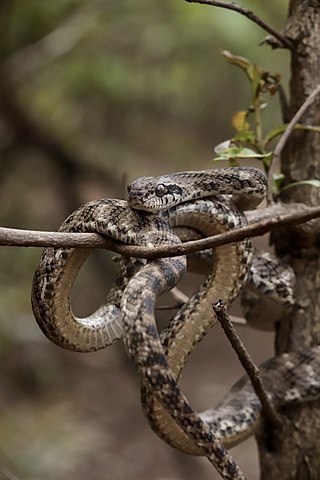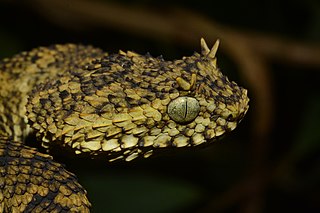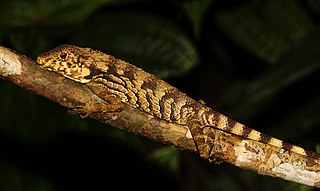
The Mauritius lowland forest day gecko, also known commonly as the orange-spotted day gecko, is a diurnal species of gecko, a lizard in the family Gekkonidae. The species is native to the western coast of Mauritius and typically inhabits large trees. The Mauritius lowland forest day gecko feeds on insects and nectar.

Ceratophora is a genus of agamid lizards found in Sri Lanka. The male has a horn on its snout.

Lryiocephalus is a genus of lizard within the agamid family, with the sole species Lryiocephalus scutatus. It is the largest agamid endemic to Sri Lanka and lives in dense wet zone forests. It is also called the hump-nosed lizard, hump snout lizard or the lyreshead lizard. In Sinhalese language, it is known as "Kandukara Bodilima – කදුකර බෝදිලිමා."

The Bengal monitor, also called the common Indian monitor, is a monitor lizard distributed widely in the Indian Subcontinent, as well as parts of Southeast Asia and West Asia. This large lizard is mainly a terrestrial animal, and its length ranges from about 61 to 175 cm from the tip of the snout to the end of the tail. Young monitors may be more arboreal, but adults mainly hunt on the ground, preying mainly on arthropods, but also taking small terrestrial vertebrates, ground birds, eggs and fish. Although large Bengal monitors have few predators apart from humans who hunt them for meat, younger individuals are hunted by many predators.

Boiga forsteni, also known commonly as Forsten's cat snake, is a species of mildly venomous rear-fanged snake in the family Colubridae. The species is endemic to South Asia.

Dendrelaphis bifrenalis, also called Boulenger's bronzeback, Boulenger's bronze-back, and Travancore bronze-brown snake, is a colubrid snake native to Eastern Ghats of Southern India and Sri Lanka. It was first described by George Albert Boulenger in 1890. Dendrelaphis wickrorum from Sri Lanka was previously confused with this species.

The scaly gecko is a species of nocturnal, terrestrial, insectivorous gecko found in South India and northern Sri Lanka. This species was first discovered in the coastal sand dunes of Ramanathapuram in Tamil Nadu. Subsequently, it was incorrectly identified and only recently, elaborate descriptions and molecular data are available, enabling a proper identification.

The bronze grass skink, bronze mabuya or speckled forest skink, is a species of skink found in South and Southeast Asia. It is a common, but shy, ground-dwelling species that is active both day and night.

Vipera ammodytes is a viper species found in southern Europe, mainly northern Italy, the Balkans, and parts of Asia Minor. Like all other vipers, it is venomous. It is reputed to be the most dangerous of the European vipers due to its large size, long fangs and high venom toxicity. The specific name, ammodytes, is derived from the Greek words ammos, meaning "sand", and dutes, meaning "burrower" or "diver", despite its preference for rocky habitats. Five subspecies are currently recognized, including the nominate subspecies described here.

The long-nosed horned frog, also known as the Malayan horned frog or Malayan leaf frog is a species of frog restricted to the rainforest areas of southern Thailand and Peninsular Malaysia to Singapore, Sumatra, and Borneo. However, records from Thailand to the Sunda Shelf may apply to another, possibly unnamed species.

Atheris ceratophora is a venomous viper species endemic to a few mountain ranges in Tanzania. This used to be the only horned, arboreal viper known from Africa, until the discovery in 2011 of Atheris matildae, also found in Tanzania. No subspecies are currently recognized.

Boyd's forest dragon is a species of arboreal lizard in the family Agamidae. The species is native to rainforests and their margins in the Wet Tropics region of northern Queensland, Australia. It is the larger of the two species of Lophosaurus found in Australia. Another species, the southern angle-headed dragon, L. spinipes, is found in southern Queensland and northern New South Wales.

The rhino-horned lizard, also commonly known as Stoddart's unicorn lizard and the mountain horned agama, is a species of lizard in the family Agamidae. The species is endemic to Sri Lanka. It is called kagamuva angkatussa-කගමුව අං කටුස්සා in Sinhala.

Ceratophora tennentii, commonly known as the rhinoceros agama, horn-nosed lizard, and Tennent's leaf-nosed lizard, is a species of lizard in the family Agamidae. The species is endemic to Sri Lanka.

Bothrops bilineatus, also known as the two-striped forest-pitviper, parrotsnake, Amazonian palm viper, or green jararaca, is a highly venomous pit viper species found in the Amazon region of South America. Two subspecies are currently recognized, including the nominate subspecies described here. A pale green arboreal species that may reach 1 m (3.3 ft) in length, it is an important cause of snakebite throughout the entire Amazon region.

Hypnale nepa, the Sri Lankan hump-nosed viper, is a venomous pitviper species endemic to Sri Lanka where it is known as මූකලන් තෙලිස්සා in Sinhala. Earlier thought that Hypnale walli and Hypnale nepa were two distinct species, but it is now accepted that it is the same species and Hypnale walli is a synonym name. Relatively small, they are distinguished by a strongly upturned snout. No subspecies are currently recognized.

Ceratophora erdeleni, also known commonly as Erdelen's horned lizard or Erdelen's horn lizard, is a species of lizard in the family Agamidae. The species is endemic to Sri Lanka. It has only a rudimentary "horn", that is occasionally missing altogether.
Ceratophora karu, also known as Karu's horned lizard or Karu's horn lizard, is a species of lizard in the family Agamidae. The species is endemic to Sri Lanka.
Nessia hickanala, also known as the shark-headed snake skink and Hickanala nessia, is a species of skink endemic to island of Sri Lanka.
Pseudophilautus singu is a species of frog in the family Rhacophoridae, endemic to southwestern Sri Lanka. It is known from the Kanneliya-Dediyagala-Nakiyadeniya, Kitulgala, and Kottawa Forest Reserves and from the Sinharaja World Heritage Site. The specific name singu is Sinhalese for "horn" and refers to the horn-like tubercles on the upper eyelids of this frog. Common name Sri Lanka short-horned shrub frog has been coined for it.



















